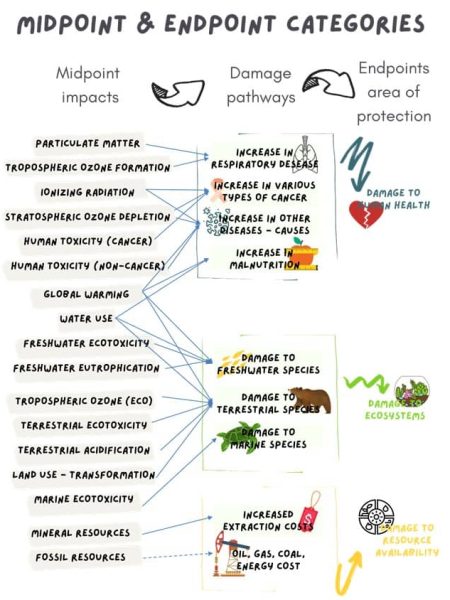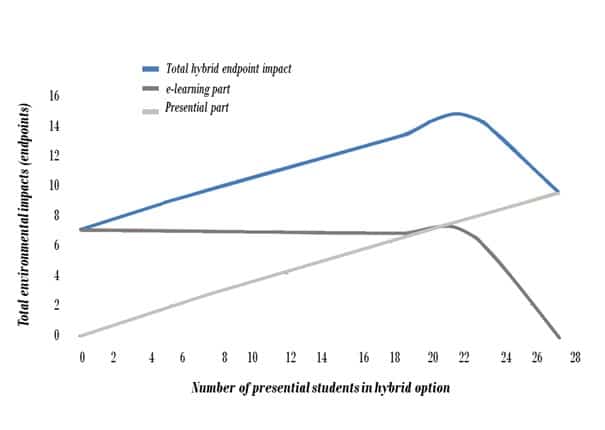Who would have thought that a presential class could have more negative impacts on the environment than an e-learning one? With the Covid-19 pandemic, education has changed drastically witnessing a distinctive rise of e-learning, whereby teaching is undertaken remotely and on digital platforms. Evaluating the impact of an e-learning and a presential regular classrooms intrigued more than one. It is under the microscope of a Life Cycle Assessment that a thorough comparison was undertaken by Asfand Yar Munir and Qingrong Zhang, two students from Ecole Polytechnique.
Reading time: 5 minutes
Tags: Environment, impact, life-cycle, e-learning, classroom, education
What is the problem?
Despite the harsh circumstances afflicted by the Covid-19 on the educational system, the digitalized way of learning and its infrastructure were relatively smoothly and quickly adopted. Online learning is most likely to be an integral part of the system even after the pandemic. But what about the environmental impacts of this new educational structure?
How is it tackled?
The authors use Open LCA to evaluate the environmental impacts throughout the entire life cycle including the upstream and downstream processes associated with each type of teaching class setting: presential and e-learning.
So what?
Depending on the parameters considered for the evaluation (number of students, proportion of foreign students, combination of classes type, etc.), the environmental impacts vary subsequently. A presential class may not always be the least offensive solution for the environment.
While environmental awareness is raising, it becomes imminent to quantify the environmental impact of our activities and operations. Therefore, considering this sudden shift away from the classroom in many parts of the globe due to the pandemic, it seems evident to evaluate whether the adoption of online learning is more respectful for the planet than regular classrooms, and how such a shift would impact the environment?
The purpose of this study intends to tackle whether asynchronous e-learning class is a more environmentally friendly setting than a regular presential classroom.
The study at a glance
The life cycle of the asynchronous learning and the presential class were based on the Energy Environment: Science Technology and Management (STEEM) maters’ class of 2019 at Ecole Polytechnique. It consists of 27 students, out of which 26 are foreign students from several different countries. The delivery of presential classes and asynchronous e-learning classes for a 7-week long course is defined by the lifecycle illustrated in the following figures. The delivery hours are set at 35.

The environmental impacts
Midpoint and endpoint look at different stages in the cause-effect chain to calculate the impact generated during a life cycle. A midpoint method looks at the impact earlier along the cause-effect chain, before the endpoint is reached. In our example, a midpoint method might look at the particulate matter or ionizing radiation. An endpoint looks at environmental impact at the end of this cause-effect chain. In this example, endpoints are the damages to human health, to ecosystems, and to resources availability.
It should be noted that the impact of manufacturing PCs, laptops, servers was not included in this study.

Presential class performs worse than e-learning class in only 3 midpoint categories out of 18
A presential class performs worse as compared to an e-learning class in climate change, human toxicity, and urban land occupation. Urban land occupation, by all means, is a factor meant to be present in a presential class owing to the element of air travel and the land provisions for it. In fact, e-learning is completely devoid of urban land occupation. A presential class, despite having lower electrical consumption, has a higher impact in the midpoint category of climate change, again due to the highly taxing nature of air travel in terms of greenhouse gas emissions. A strikingly high impact result is seen for e-learning in the impact category of ionizing radiation. This is the result of higher electricity consumption requirements in the production phase of the e-learning class. Given that most of the electricity mix of France originates from nuclear power hence ionizing radiation had a positive relation with electricity consumption.
Asynchronous e-learning have a lesser total impact at endpoint categories
Although, when considering the number of impact results, it may be noticed that e-learning may have an overall higher impact as compared to a presential class. But in reality, this may not be the case as the real impact at the endpoint may be different depending on the modelling from the midpoint to endpoint category namely ecosystem, health and resources. Results have shown that the impact on the ecosystem from e-learning is 3% less than that of a presential class. Most of the impact on ecosystem quality in presential class originates from urban land occupation. However, asynchronous e-learning has a greater impact on human health. Most of the impact on human health by asynchronous e-learning originates from particulate matter formation. Presential class has a 35% higher impact on total endpoints.
Fine tuning the data: What about another class size?
Classes vary in size, and therefore, to conclude whether an e-learning or presential class has less impacts, one needs to compute and obtain results at several different class sizes. The results indicate that below 19 students, presential classes perform better environmentally, while classes with more than 19 students in e-learning are better.
Fine tuning the data: What about a Hybrid Solution?
A hybrid approach is the option where some students can participate through asynchronous e-learning and others can be present in class. It has been investigated in terms of its total endpoint impact result. Key lessons are that hybrid classes are always worse (whatever the composition of the hybrid option) compared to a total e-learning class. When compared with the option of total presential classes, for the number of presential students greater than 7, hybrid classes have a higher endpoint impact. A hybrid class with less than 7 presential students will make it less environmentally taxing as compared to a full presential class, but its impact, however, would still be higher compared to a fully asynchronous e-learning one.
An interesting fact worth mentioning is that the moment one student needs an e-learning platform the whole system associated with it needs to be activated. This generates a rapid rise in endpoints impact, reaching a peak when 20 students are using the online platform, and then reducing dramatically when the number is above 20 students.

Caught in a pinch?
The results of this study are not indisputable. On the one hand, the LCA although being a very promising method, is still subject to bias . On the other hand, the evaluation is limited by the intrinsic characteristics of the studied class. We are dealing with a very multicultural class. In fact, 26 out of 27 of the students are foreigners, which generates the largest share of environmental impact. According to the study, air traveling accounts to 96% of the negative impacts of a presential classroom. A more “local” class will perhaps have less environmental impact.
We therefore find ourselves caught in a pinch: opting for an international social and cultural mix or paying the price of the globalization of education?
LCA at the services of a sustainable planet
In the midst of the socio-economic and environmental chaos we are living in, one ought to take a step back in order to make sound decisions. Assessing and reevaluating the impact we have on our planet is a must. Therefore, revolutionizing the LCA approach will help meet new aspirations vis-a-vis the wellbeing of Earth while responding to the needs of stakeholders to seek better decisions for a sustainable planet
About the author
Farah Doumit is a PhD student at Ecole Polytechnique Management Research Center. Her research focuses on subjects related to innovative business model enhancing the transition toward a circular economy, particularly in the fields of waste, water, and energy.
1 Huijbregts, M.A.J., ReCiPe 2016: A harmonized life cycle impact assessment method at midpoint and endpoint level Report I: Characterization.
2 Goran Finnveden , M.Z.H., Tomas Ekvall , Jeroen Guine, Reinout Heijungs ,Stefanie Hellweg, Annette Koehler, David Pennington , Sangwon Suh, Recent developments in Life Cycle Assessment. 2009

